2019年6月全国翻译专业资格(水平)考试二级口译实务真题(人事部CATTI考试)
2019年CATTI二级笔译英译汉真题及参考答案
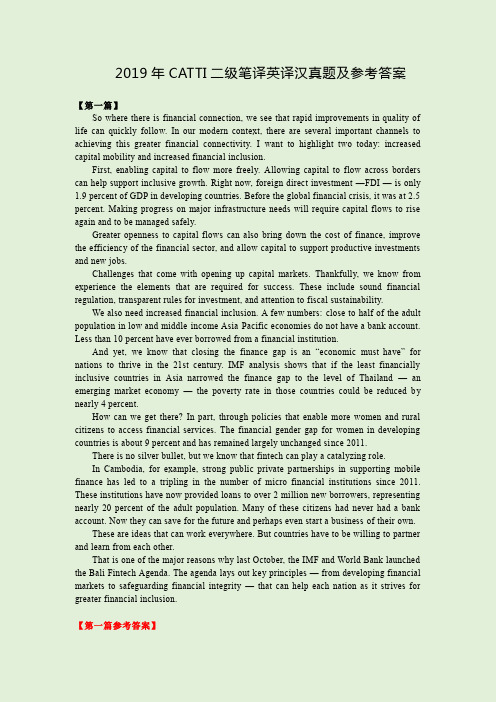
2019年CATTI二级笔译英译汉真题及参考答案【第一篇】So where there is financial connection, we see that rapid improvements in quality of life can quickly follow. In our modern context, there are several important channels to achieving this greater financial connectivity. I want to highlight two today: increased capital mobility and increased financial inclusion.First, enabling capital to flow more freely. Allowing capital to flow across borders can help support inclusive growth. Right now, foreign direct investment —FDI — is only 1.9 percent of GDP in developing countries. Before the global financial crisis, it was at 2.5 percent. Making progress on major infrastructure needs will require capital flows to rise again and to be managed safely.Greater openness to capital flows can also bring down the cost of finance, improve the efficiency of the financial sector, and allow capital to support productive investments and new jobs.Challenges that come with opening up capital markets. Thankfully, we know from experience the elements that are required for success. These include sound financial regulation, transparent rules for investment, and attention to fiscal sustainability.We also need increased financial inclusion. A few numbers: close to half of the adult population in low and middle-income Asia-Pacific economies do not have a bank account. Less than 10 percent have ever borrowed from a financial institution.And yet, we know that closing the finance gap is an “economic must-have” for nations to thrive in the 21st century. IMF analysis shows that if the least financially inclusive countries in Asia narrowed the finance gap to the level of Thailand — an emerging market economy — the poverty rate in those countries could be reduced by nearly 4 percent.How can we get there? In part, through policies that enable more women and rural citizens to access financial services. The financial gender gap for women in developing countries is about 9 percent and has remained largely unchanged since 2011.There is no silver bullet, but we know that fintech can play a catalyzing role.In Cambodia, for example, strong public-private partnerships in supporting mobile finance has led to a tripling in the number of micro-financial institutions since 2011. These institutions have now provided loans to over 2 million new borrowers, representing nearly 20 percent of the adult population. Many of these citizens had never had a bank account. Now they can save for the future and perhaps even start a business of their own.These are ideas that can work everywhere. But countries have to be willing to partner and learn from each other.That is one of the major reasons why last October, the IMF and World Bank launched the Bali Fintech Agenda. The agenda lays out key principles — from developing financial markets to safeguarding financial integrity — that can help each nation as it strives for greater financial inclusion.【第一篇参考答案】哪里形成了金融联系,当地的生活质量就会很快改善。
2019下半年CATTI二级口译真题
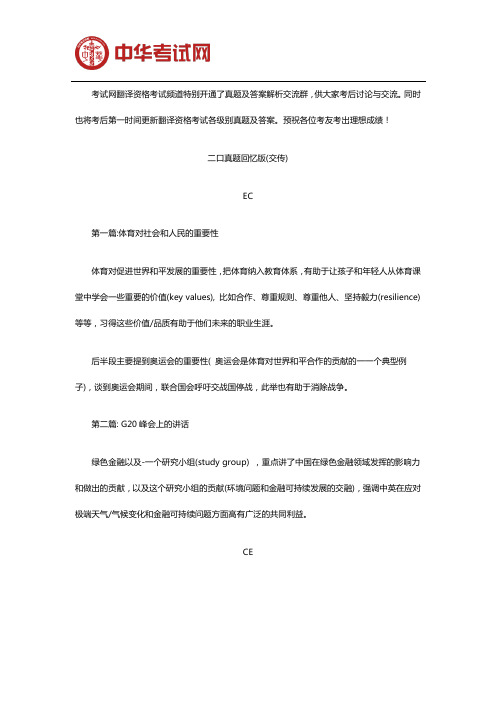
考试网翻译资格考试频道特别开通了真题及答案解析交流群,供大家考后讨论与交流。
同时也将考后第一时间更新翻译资格考试各级别真题及答案。
预祝各位考友考出理想成绩!二口真题回忆版(交传)EC第一篇:体育对社会和人民的重要性体育对促进世界和平发展的重要性,把体育纳入教育体系,有助于让孩子和年轻人从体育课堂中学会一些重要的价值(key values), 比如合作、尊重规则、尊重他人、坚持毅力(resilience)等等,习得这些价值/品质有助于他们未来的职业生涯。
后半段主要提到奥运会的重要性( 奥运会是体育对世界和平合作的贡献的一一个典型例子),谈到奥运会期间,联合国会呼吁交战国停战,此举也有助于消除战争。
第二篇: G20峰会上的讲话绿色金融以及-一个研究小组(study group) ,重点讲了中国在绿色金融领域发挥的影响力和做出的贡献,以及这个研究小组的贡献(环境问题和金融可持续发展的交融),强调中英在应对极端天气/气候变化和金融可持续问题方面高有广泛的共同利益。
CE第一篇:有关中美经贸合作关系的讲话是访美期间的一次午餐会上的发言,提到了美国换届选举之后,可能会对中美经贸合作关系产生的影响,强调中国是美国最大的贸易伙伴,中美进出口及投资领域目前以及未来的广泛合作(涉及了很多数据)。
第二篇:有关难民问题的应对方式提到了由于地区动荡、战乱恐怖主义、发展不平衡等原因,导致难民数量达到二战以来的最高值。
强调要加强国际合作以应对难民危机,难民危机是人道主义危机。
中国在解决难民问题方面做出了贡献(政策和资金支持),中方强调要加强各国合作,共同打击非法偷渡、人口贩卖、恐怖主义。
焚题库,是基于大数据的人工智能算法研发而成的考试题库,专注于根据不同考试的考点、考频、难度分布,提供考试真题解析、章节历年考点考题、考前强化试题、高频错题榜等。
查看完整试题、答案解析等更多考试资料,尽在中华考试网……。
2019年catti笔译二级试题:宜家

英格瓦·坎普拉德可不是一般的亿万富翁。
这位宜家家具帝国的创始人乘坐经济舱旅行,开着一辆有十年历史的沃尔沃汽车,总是下午去买水果和蔬菜,因为这时价格往往便宜些。
如果有人问他生活中有什么奢侈的消费时,他的回答是:我偶尔喜欢买一件高档衬衫或一条围巾,吃点瑞典鱼子酱。
‛坎普拉德先生是战后欧洲最杰出企业家之一。
宜家创建于1943,当时仅仅从事邮购业务,现如今已经发展成为在全球31个国家经营,员工总数超过7万的国际化零售业巨头。
宜家的销售额逐年上涨。
宜家的产品目录是全世界印数最多的印刷品,每年达到不可思议的1.1亿册。
坎普拉德先生也变得异常富有。
根据美国《福布斯》杂志,他的身价达到134亿美元(87亿英镑),位列全球第17位。
宜家之所以取得了令人惊异的成功,首先是因为它那简单得令人难以置信的经营理念:向老百姓提供设计精美而又买得起的家具。
其次就是坎普拉德本人,有魅力、谦逊、随和。
他的思想和价值观绝对是宜家哲学的核心。
坎普拉德先生因生活极其节俭而闻名遐迩。
他清洗用过的塑料杯以便再次利用。
前不久,他决定不再让那位已经为他理发多年的瑞典理发师继续为他提供服务,原因是在现居地瑞士他找到一位理发师,每次只收14瑞士法郎(6英镑)。
‚这数字合理,‛他笑着说。
宜家所有的高管都十分了解成本意识的重要性。
公司不鼓励他们乘坐头等舱或商务舱旅行。
‚最好的领导方式是以身作则‛,坎普拉德先生说过,‚让我坐头等舱,而让我的同事们坐旅游舱,是我绝对不能接受的。
‛他巡视宜家集团的店铺时,他总是要和员工们握手或拥抱,以此向员工传递一种‚伙伴‛的感觉,这种做法在瑞典绝不多见。
‚叫我英格瓦,‛他对员工说。
他不喜欢打领带,而是喜欢敞开衬衫的领口,这样的衣着方式也突显了他的不拘礼节和没有等级观念。
在个人生活方面和事业方面坎普拉德先生都经历过艰苦的奋斗过程。
他一直与读写困难症和其他疾病抗争。
他性格中很突出的一点就是对细节的偏执性关注。
巡视他的商店时,他不仅和经理们交谈,还要和最基层的员工以及顾客们交谈。
2019年6月全国翻译专业资格(水平)考试一级笔译实务真题(人事部CATTI考试)

2019年6月CATTI全国翻译专业资格(水平)考试英语一级《笔译实务》试题Section 1: translationPart 1 English-Chinese translation(英译汉)(40points)There was a time when people used to love reading books and they used to read books only for their own pleasure. The traditional pleasures of reading are more complex than just enjoyment. They involve patience, solitude, contemplation. And therefore the books that are most at risk from our attention are these that require a bit of effort. In order for this to work, however, we need a certain type of silence, an ability to filter out the noise. Such a state is increasingly elusive in our over-networked culture, in which every rumour and mundanity is blogged and tweeted. Today, it seems it is not contemplation we seek but an odd sort of distraction masquerading as being in the know. Why? Because of the illusion that illumination is based on speed, that it is more important to react than to think, that we live in a culture in which something is attached to every bit of time.In one sense, this is just the latest twist in a story that has been growing for nearly a century. It seems that each new media invention —movies, radio, television, VCRs and DVD players, and the Internet-inevitably affects the way people read and reduces the time they devote to it. These days, after spending hours reading e-mails and fielding phone calls in the office, tracking stories across countless websites, I find it difficult to quiet down. Besides, most people read to be informed and instructed -where to take a vacation, how to cook, how to invest their money. Less frequently, the reasons may be escapist or to be entertained, to forgo the boredom or anxiety of their daily lives.A mode of thinking is being lost,” laments Neil Postman, whose book “Amusing Ourselves to Dea th,” is a warning about the consequences of a falloff in reading. American politics, religion, news, athletics, education, and commerce have been transformed into congenial adjuncts of show business. Ironically, but not coincidentally, reading has begun fading from our culture at the very moment that its importance to that culture is finally being established. Its decline, many theorists believe, is as profound as, say, the fall of communism, and some have taken to prophesying that the downturn in reading could result in the modern world's cultural and political decline. Optimists, however, suggest that the widespread notion that reading is in decline is an oversimplification, citing statistics showing books, the oldest form of print, seem to be doing reasonably well and publishers, in fact, arechurning out more and more books.Ah,but are those books actually being read? Not, in many cases, from cover to cover. In a society where professional success now requires acquaintance with masses of esoteric information, books are often purchased to be consulted, not read. About 15% of the new titles in "Books in Print" are scientific or technical books. Fiction and general-interest nonfiction works would seem to be designed to be read, but lately these books also serve other functions. Their authors often employ them as routes to movie contracts or to tenure or to the intellectual renown. Their publishers increasingly see these books not as collections of ideas and information but as products that must be publicized and marketed so the profits of the large conglomerates they now work for may rise. Reading still plays and, for the foreseeable future, will continue to play, a crucial role in our society. Nevertheless, there is no getting around the fact that reading's role has diminished and likely will continue to shrink.Part 2: Chinese-English translation(汉译英)(40points)“老夫久居大都市,刚刚和家人去乡下盘桓三日,白天在田间徜徉,夜里听虫鸣蛙声入眠。
catti二级口译试题及解析
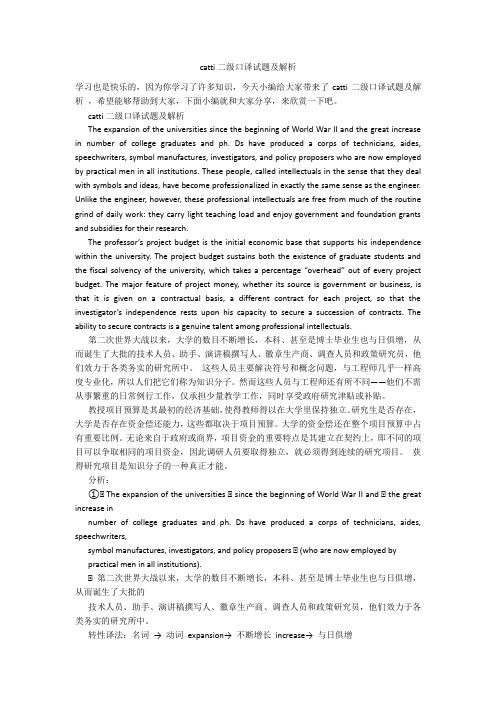
catti二级口译试题及解析学习也是快乐的,因为你学习了许多知识,今天小编给大家带来了catti二级口译试题及解析,希望能够帮助到大家,下面小编就和大家分享,来欣赏一下吧。
catti二级口译试题及解析The expansion of the universities since the beginning of World War II and the great increase in number of college graduates and ph. Ds have produced a corps of technicians, aides, speechwriters, symbol manufactures, investigators, and policy proposers who are now employed by practical men in all institutions. These people, called intellectuals in the sense that they deal with symbols and ideas, have become professionalized in exactly the same sense as the engineer. Unlike the engineer, however, these professional intellectuals are free from much of the routine grind of daily work: they carry light teaching load and enjoy government and foundation grants and subsidies for their research.The professor’s project budget is the initial economic base that supports his independence within the university. The project budget sustains both the existence of graduate students and the fiscal solvency of the university, which takes a percentage “overhead” out of every project budget. The major feature of project money, whether its source is government or business, is that it is given on a contractual basis, a different contract for each project, so that the investigator’s independence rests upon his capacity to secure a succession of contracts. The ability to secure contracts is a genuine talent among professional intellectuals.第二次世界大战以来,大学的数目不断增长,本科、甚至是博士毕业生也与日俱增,从而诞生了大批的技术人员、助手、演讲稿撰写人、徽章生产商、调查人员和政策研究员,他们效力于各类务实的研究所中。
2019年catti笔译二级试题:赢家

Winners do not dedicate their lives to a concept of what they imagine they should be: rather, they are themselves and as such do not use their energy putting on a performance, maintaining pretence, and manipulating others. They are aware that there is a difference between being loving and acting loving, between being stupid and acting stupid, between being knowledgeable and acting knowledgeable. Winners do not need to hide behind a mask. Winners are not afraid to do their own thinking and to use their own knowledge. They can separate facts from opinions and don’t pretend to have all the answers. They listen to others, evaluate what they say, but come to their own conclusions. Although winners can adore and respect other people, they are not totally defined, demolished, bound, or awed by them.Winners do not play “helpless”, nor do they play the blaming game. Instead, they assume responsibility for their own lives.【参考译文】赢家从来都不会毕生致力于这样概念:即想象自己应该成为何种人。
CATTI 二级口译真题

口译交传实务1、英汉交替传译(50分)①英译汉第一篇:段落大意(回忆版):世界银行关于中国扶贫的讲话In December, this years marks the 14th year since Deng Xiaoping’s reform and opening up.He delivered a speech at that time to emphasize its importance. Since then China started four decades of reform and opening up and becomes the 2nd largest economy in the world and transformed from a low to high income country.During the past four decades, we’ve made significant progress in different sectors.China has made great achievements in alleviating extreme poverty. How? Two reasons: 1.Reform and opening as a foundation for fast economy development 2.Focused and sustainable strategy and development-oriented policy.There are some lessons we can learn from China:1. political support from DXP and Xi jin ping made poverty alleviation one of his three decisive battles 2. Organizations, both central and local ones have designed and carried out effective policies. WBG, as a partner of China, provides solution(south west project, PLATO project). Most poverty is in rural areasChina targets the poorest and the most vulnerable, helps improve productivity and income. China built up regional projects including China Western Development and a strategy from villages to households, which have helped 17 million people get rid of extreme poverty. It’s reaching its final mile to comprehensive success.第二篇:段落大意(回忆版):中非合作关系Africa is a land of vast resources, but owing to a history of colonization and exploitation, it has not been able to transform this natural abundance into wealth for its citizens. Today African nations are focusing on nation building, but a massive infrastructure gap-estimated at US$130-170 billion a year by the African Development Bank-is holding them back.Even after the colonial era.occupying nations never really left Africa. African countries became independent nation states, but imperialist powers continued to drain their resources.At the start of the 21st century, China, with its economic muscle fuelled by its strong industrial base, arrived in Africa with a completely different approach. It wanted to help build up the continent and it gave local governments freedom to utilize resources for themselves.China brought along its own invaluable experience of infrastructure development.It lifted millions of its people out of poverty through networks of expressways and railways that connected all parts of the country. The upgraded national infrastructure connected rural areas with industrial areas and cities. Railways contributed to the long -term growth of China and resulted in an enormous inflow of foreign investment, further boosting the national economyChina is now using its experience in developing its own domestic infrastructure to revive the ancient silk trading routes under the Belt and Road Initiative(BRI). Announced in 2013, the BRI is principally an infrastructure project aimed at improving the connectivity of major industrial hubs and markets.Now China is offering to Africa the experience it has accumulated in developing infrastructure in China and abroad. Since the construction of the railway line from Tanzani a to Zambia in the 1970s, China's aim to bring more development to Africa has made significant progress.A cornerstone of recent Chinese projects is the railway line from Kenya's capital city of Nairobi to the port of Mombasa.This line became operational last year and is the country’s largest infrastructure project since its independence. The railway line isexpected to further connect South Sudan, Rwanda, Burundi, Ethiopia and the Democratic Republic of Congo when it begins its expansion phase.Apart from building a ring road and a six-lane highway, Ethiopia has seen an upsurge in economic activity after China funded the Addis Ababa-Djibouti Railway. This line connected the land-locked country with the coast of the Red Sea and collectively, these projects have contributed towards making Ethiopia the fastest growing economy in Africa.2、汉英交替传译(50分)②汉译英第一篇:进博会首届进博会是中国为维护多边贸易体制、支持经济全球化搭建的一个公共平台,也是国际公共产品,是推动我国经济高质量发展、满足企业发展进步和人民美好生活需要的一个有效载体。
2019年6月CATTI二级笔译实务参考答案及全面解析
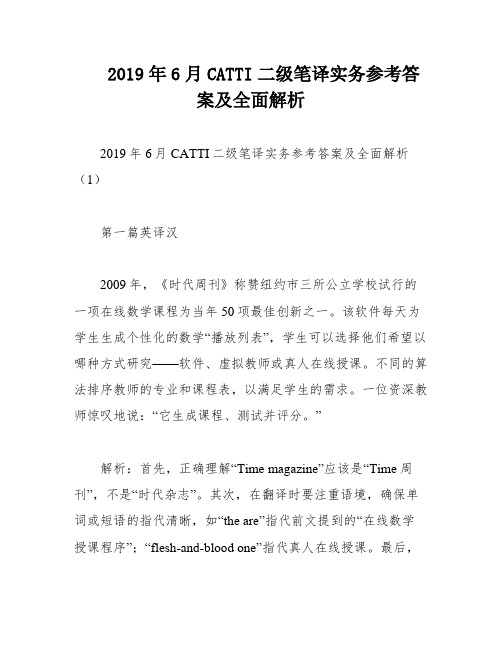
2019年6月CATTI二级笔译实务参考答案及全面解析2019年6月CATTI二级笔译实务参考答案及全面解析(1)第一篇英译汉2009年,《时代周刊》称赞纽约市三所公立学校试行的一项在线数学课程为当年50项最佳创新之一。
该软件每天为学生生成个性化的数学“播放列表”,学生可以选择他们希望以哪种方式研究——软件、虚拟教师或真人在线授课。
不同的算法排序教师的专业和课程表,以满足学生的需求。
一位资深教师惊叹地说:“它生成课程、测试并评分。
”解析:首先,正确理解“Time magazine”应该是“Time周刊”,不是“时代杂志”。
其次,在翻译时要注重语境,确保单词或短语的指代清晰,如“the are”指代前文提到的“在线数学授课程序”;“flesh-and-blood one”指代真人在线授课。
最后,要注意词语的选择,如“different algorithm”可以翻译成“独特算法”,而不是简单的“不同的计算程序”。
在2009年,《时代周刊》发表文章,称赞一种在线数学教育新程序,将其列为当年50大杰出创新成果之一。
该程序已在纽约市的3所公立学校进行试点运行。
该课程软件每日更新授课内容,以满足学生不同的需求,并提供多种播放模式选择,包括软件或虚拟教师授课,以及真人在线教学。
该课程软件采用独特的算法,对教师的专业和排课时间进行分类,以满足每位学生的需求。
一位经验丰富的教师赞叹道,“该软件不仅提供在线课程,还有测试环节,并能对测试内容进行评分。
”原文中没有格式错误或明显有问题的段落)XXX’s future。
The report called for a series ofreforms that XXX school days and years。
morehomework。
higher standards and more testing。
It also called forschools to adopt “computer-based XXX.” This reportset the stage for a new era of school XXX.Andrea Gabor's book。
翻译资格考试二级笔译综合能力及实务真题详解
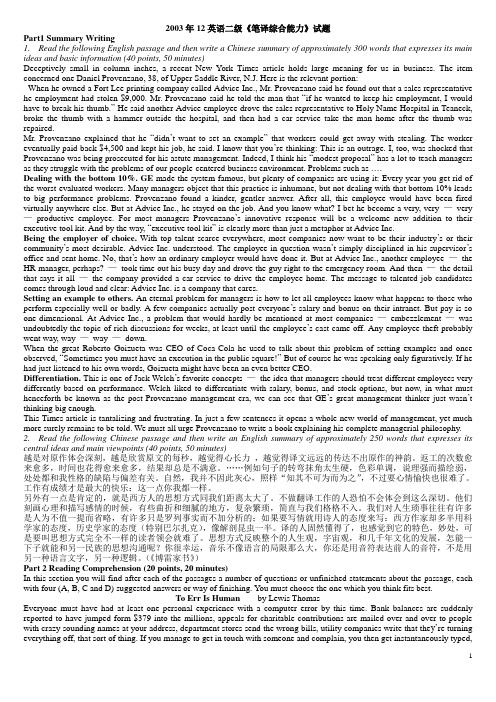
2003年12英语二级《笔译综合能力》试题Part1 Summary Writing1.Read the following English passage and then write a Chinese summary of approximately 300 words that expresses its main ideas and basic information (40 points, 50 minutes)Deceptively small in column inches, a recent New York Times article holds large meaning for us in business. The item concerned one Daniel Provenzano, 38, of Upper Saddle River, N.J. Here is the relevant portion:When he owned a Fort Lee printing company called Advice Inc., Mr. Provenzano said he found out that a sales representative he employment had stolen $9,000. Mr. Provenzano said he told the man that “if he wanted to keep his employment, I would have to break his thumb.” He said another Advice employee drove the sales representative to Holy Name Hospital in Teaneck, broke the thumb with a hammer outside the hospital, and then had a car service take the man home after the thumb was repaired.Mr. Provenzano explained that he “didn’t want to set an example”that workers could get away with stealing. The worker eventually paid back $4,500 and kept his job, he said. I know that you’re thinking: This is an outrage. I, too, was shocked that Provenzano was being prosecuted for his astute management. Indeed, I think his “modest proposal” has a lot to teach managers as they struggle with the problems of our people-centered business environment. Problems such as ….Dealing with the bottom 10%. GE made the system famous, but plenty of companies are using it: Every year you get rid of the worst-evaluated workers. Many managers object that this practice is inhumane, but not dealing with that bottom 10% leads to big performance problems. Provenzano found a kinder, gentler answer. After all, this employee would have been fired virtually anywhere else. But at Advice Inc., he stayed on the job. And you know what? I bet he become a very, very —very —productive employee. For most managers Provenzano’s innovative response will be a welcome new addition to their executive tool kit. And by the way, “executive tool kit” is clearly more than just a metaphor at Advice Inc.Being the employer of choice. With top talent scarce everywhere, most companies now want to be their industry’s or their community’s most desirable. Advice Inc. understood. The employee in question wasn’t simply disciplined in his supervisor’s office and sent home. No, that’s how an ordinary employer would have done it. But at Advice Inc., another employee —the HR manager, perhaps? —took time out his busy day and drove the guy right to the emergency room. And then —the detail that says it all —the company provided a car service to drive the employee home. The message to talented job candidates comes through loud and clear: Advice Inc. is a company that cares.Setting an example to others. An eternal problem for managers is how to let all employees know what happens to those who perform especially well or badly. A few companies actually post everyone’s salary and bonus on their intranet. But pay is so one-dimensional. At Advice Inc., a problem that would hardly be mentioned at most companies —embezzlement —was undoubtedly the topic of rich discussions for weeks, at least until the employee’s cast came off. Any employee theft probably went way, way —way —down.When the great Roberto Goizueta was CEO of Coca-Cola he used to talk about this problem of setting examples and once observed, “Sometimes you must have an execution in the public square!” But of course he was speaking only figuratively. If he had just listened to his own words, Goizueta might have been an even better CEO.Differentiation. This is one of Jack Welch’s favorite concepts —the idea that managers should treat different employees very differently based on performance. Welch liked to differentiate with salary, bonus, and stock options, but now, in what must henceforth be known as the post-Provenzano management era, we can see that GE’s great management thinker just wasn’t thinking big enough.This Times article is tantalizing and frustrating. In just a few sentences it opens a whole new world of management, yet much more surely remains to be told. We must all urge Provenzano to write a book explaining his complete managerial philosophy. 2.Read the following Chinese passage and then write an English summary of approximately 250 words that expresses its central ideas and main viewpoints (40 points, 50 minutes)越是对原作体会深刻,越是欣赏原文的每秒,越觉得心长力,越觉得译文远远的传达不出原作的神韵。
2019翻译资格考试catti二级口译练习试题1
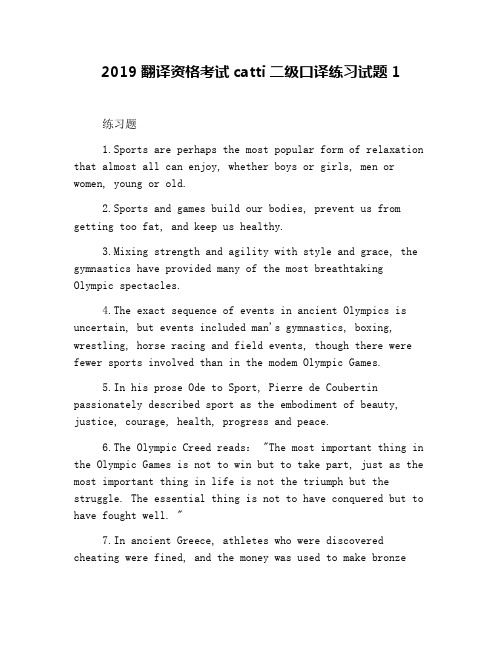
2019翻译资格考试catti二级口译练习试题1练习题1.Sports are perhaps the most popular form of relaxation that almost all can enjoy, whether boys or girls, men or women, young or old.2.Sports and games build our bodies, prevent us from getting too fat, and keep us healthy.3.Mixing strength and agility with style and grace, the gymnastics have provided many of the most breathtaking Olympic spectacles.4.The exact sequence of events in ancient Olympics is uncertain, but events included man's gymnastics, boxing, wrestling, horse racing and field events, though there were fewer sports involved than in the modem Olympic Games.5.In his prose Ode to Sport, Pierre de Coubertin passionately described sport as the embodiment of beauty, justice, courage, health, progress and peace.6.The Olympic Creed reads: "The most important thing in the Olympic Games is not to win but to take part, just as the most important thing in life is not the triumph but the struggle. The essential thing is not to have conquered but to have fought well. "7.In ancient Greece, athletes who were discovered cheating were fined, and the money was used to make bronzestatues of Zeus, which were erected on the road to the stadium.8.Boxing brings into play the various groups of muscles almost as harmoniously as rowing, and like rowing has the advantage of ruling out one source of nervous fatigue holding back.9.Long-distance rally driving dates back to an eventthat took place in 1907 when vehicles set out on a two-month trek from China to France. Four years later in 1911, the famous Monte Carlo Rally was inaugurated as the world's leading annual international rallying event.10.Total well-being means applying healthy lifestyle habits such as not smoking, managing stress, and eating a smart diet, as well as exercising regularly.答案1.体育运动大概是几乎所有人都喜爱的最普遍的令人松弛的娱乐形式,男孩女孩,男女老少都很喜爱体育运动。
2019年CATTI二级笔译英译汉真题及参考答案(2021年整理精品文档)
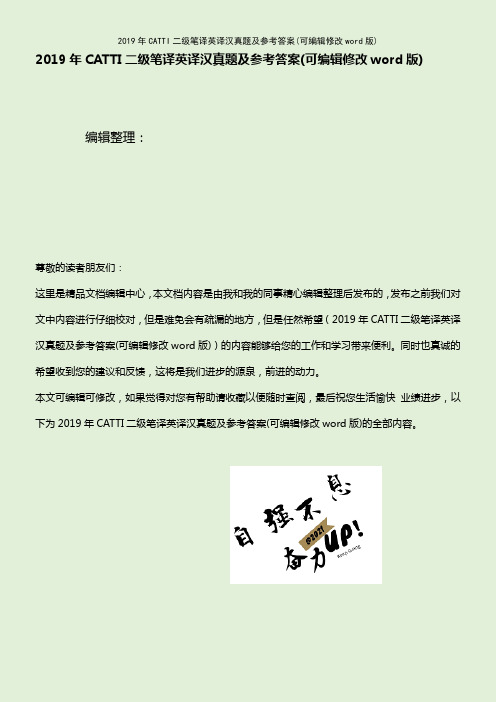
2019年CATTI二级笔译英译汉真题及参考答案(可编辑修改word版) 编辑整理:尊敬的读者朋友们:这里是精品文档编辑中心,本文档内容是由我和我的同事精心编辑整理后发布的,发布之前我们对文中内容进行仔细校对,但是难免会有疏漏的地方,但是任然希望(2019年CATTI二级笔译英译汉真题及参考答案(可编辑修改word版))的内容能够给您的工作和学习带来便利。
同时也真诚的希望收到您的建议和反馈,这将是我们进步的源泉,前进的动力。
本文可编辑可修改,如果觉得对您有帮助请收藏以便随时查阅,最后祝您生活愉快业绩进步,以下为2019年CATTI二级笔译英译汉真题及参考答案(可编辑修改word版)的全部内容。
2019年CATTI二级笔译英译汉真题及参考答案【第一篇】So where there is financial connection, we see that rapid improvements in quality of life can quickly follow。
In our modern context, there are several important channels to achieving this greater financial connectivity. I want to highlight two today:increased capital mobility and increased financial inclusion.First, enabling capital to flow more freely。
Allowing capital to flow across borders can help support inclusive growth. Right now, foreign direct investment —FDI - is only 1.9 percent of GDP in developing countries。
catti二级口译实务考试试题及答案解析
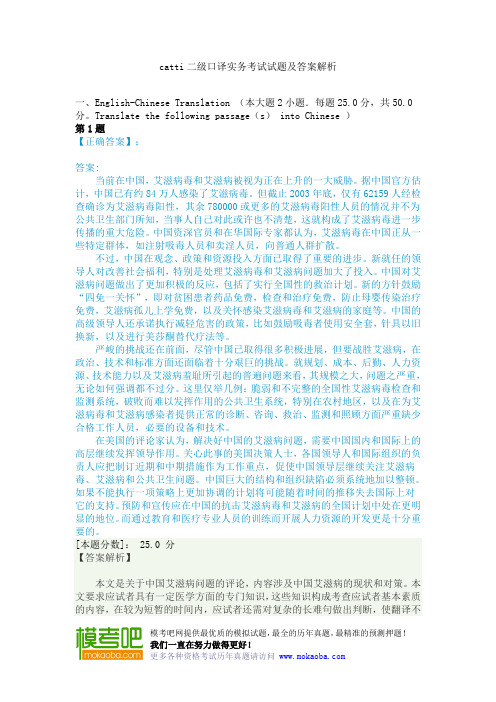
模考吧网提供最优质的模拟试题,最全的历年真题,最精准的预测押题!catti 二级口译实务考试试题及答案解析一、English-Chinese Translation (本大题2小题.每题25.0分,共50.0分。
Translate the following passage (s ) into Chinese )第1题【正确答案】:答案:当前在中国,艾滋病毒和艾滋病被视为正在上升的一大威胁。
据中国官方估计,中国已有约84万人感染了艾滋病毒。
但截止2003年底,仅有62159人经检查确诊为艾滋病毒阳性,其余780000或更多的艾滋病毒阳性人员的情况并不为公共卫生部门所知,当事人自己对此或许也不清楚,这就构成了艾滋病毒进一步传播的重大危险。
中国资深官员和在华国际专家都认为,艾滋病毒在中国正从一些特定群体,如注射吸毒人员和卖淫人员,向普通人群扩散。
不过,中国在观念、政策和资源投入方面已取得了重要的进步。
新就任的领导人对改善社会福利,特别是处理艾滋病毒和艾滋病问题加大了投入。
中国对艾滋病问题做出了更加积极的反应,包括了实行全国性的救治计划。
新的方针鼓励“四免一关怀”,即对贫困患者药品免费,检查和治疗免费,防止母婴传染治疗免费,艾滋病孤儿上学免费,以及关怀感染艾滋病毒和艾滋病的家庭等。
中国的高级领导人还承诺执行减轻危害的政策,比如鼓励吸毒者使用安全套,针具以旧换新,以及进行美莎酮替代疗法等。
严峻的挑战还在前面,尽管中国已取得很多积极进展,但要战胜艾滋病,在政治、技术和标准方面还面临着十分艰巨的挑战。
就规划、成本、后勤、人力资源、技术能力以及艾滋病羞耻所引起的普遍问题来看,其规模之大,问题之严重,无论如何强调都不过分。
这里仅举几例:脆弱和不完整的全国性艾滋病毒检查和监测系统,破败而难以发挥作用的公共卫生系统,特别在农村地区,以及在为艾滋病毒和艾滋病感染者提供正常的诊断、咨询、救治、监测和照顾方面严重缺少合格工作人员,必要的设备和技术。
2019年翻译资格考试catti二级笔译试题及答案
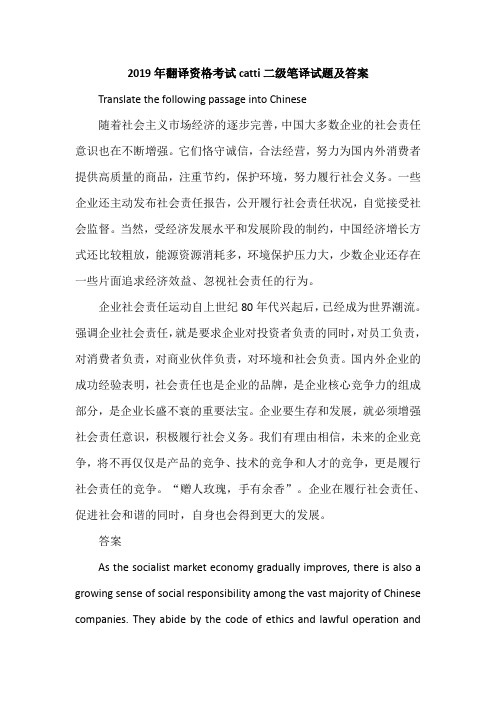
2019年翻译资格考试catti二级笔译试题及答案Translate the following passage into Chinese随着社会主义市场经济的逐步完善,中国大多数企业的社会责任意识也在不断增强。
它们恪守诚信,合法经营,努力为国内外消费者提供高质量的商品,注重节约,保护环境,努力履行社会义务。
一些企业还主动发布社会责任报告,公开履行社会责任状况,自觉接受社会监督。
当然,受经济发展水平和发展阶段的制约,中国经济增长方式还比较粗放,能源资源消耗多,环境保护压力大,少数企业还存在一些片面追求经济效益、忽视社会责任的行为。
企业社会责任运动自上世纪80年代兴起后,已经成为世界潮流。
强调企业社会责任,就是要求企业对投资者负责的同时,对员工负责,对消费者负责,对商业伙伴负责,对环境和社会负责。
国内外企业的成功经验表明,社会责任也是企业的品牌,是企业核心竞争力的组成部分,是企业长盛不衰的重要法宝。
企业要生存和发展,就必须增强社会责任意识,积极履行社会义务。
我们有理由相信,未来的企业竞争,将不再仅仅是产品的竞争、技术的竞争和人才的竞争,更是履行社会责任的竞争。
“赠人玫瑰,手有余香”。
企业在履行社会责任、促进社会和谐的同时,自身也会得到更大的发展。
答案As the socialist market economy gradually improves, there is also a growing sense of social responsibility among the vast majority of Chinese companies. They abide by the code of ethics and lawful operation andare committed to providing high-quality products for domestic and foreign consumers. They pay attention to conservation, environmental protection and CSR fulfillment.Some companies go even further by publishing their CSR reports to disclose their CSR performance and to voluntarily subject themselves to public scrutiny. Of course, constrained by the level and stage of its economic development, China still practices a rough-edged economic growth model, featuring high energy and resources consumption and high environmental costs. A handful of companies are still single-mindedly seeking profits and turning a blind eye to their social responsibilities.Since the 1980s, CSR has become to a global trend. Putting emphasis on CSR means companies not only have to be responsible to their investors, but also to their employees, customers, business partners, and to the environment and society. International success stories also show that CSR is part of a company's brand image and its core competitiveness. It is a vital source of sustained prosperity for business. So in order to survive and grow, it is imperative that companies should raise their CSR awareness and actively fulfill their social responsibilities. We have every reason to believe that future business competition will diversify from specific products, technology and talents toward CSR performance. As the proverb goes, "The rose is in her hand and thefragrance in mine". Companies benefit from their efforts to honor CSR and promote social harmony.Translate the following passage into Chinese.Born in 1451, the son of an Italian weaver, Christopher Columbus took to the sea at an early age, making up for his lack of formal education by teaching himself geography, navigation, and Latin. By the 1480s Columbus - a tall, red-haired, long-faced man with a ruddy complexion, oval eyes, and a prominent nose - was an experienced seaman. Dazzled by the prospect of Asian riches, he hatched a scheme to reach the Indies (India, China, the East Indies, or Japan) by sailing west. After the courts of Portugal, England, and France showed little interest in his plan, Columbus turned to Spain for backing. He won the support of Ferdinand and Isabella, the Spanish monarchs, and himself raised much of the money needed to finance the voyage. The legend that the queen had to hock the crown jewels is as spurious as the fable that Columbus set out to prove the earth was round.Columbus chartered one seventy-five-foot ship, the Santa Maria, and the Spanish city of Palos supplied two smaller caravels, the Pinta and Nina. From Palos this little squadron, with eighty-seven officers and men, set sail westward for what Columbus thought was Asia. The first leg of the journey went well, thanks to a strong trade wind. But then the breeze lagged, the days passed, and the crew began to grumble about。
2019年6月CATTI二级笔译实务参考答案及全面解析

2019年6月CATTI二级笔译实务参考答案及全面解析(1)第一篇英译汉In 2009, Time magazine hailed an online math program piloted at three New York City public schools, as one of the year’s 50 best innovations. Each day, the software generated individualized math “playlists” for students who then chose the “modality” in which they wished to learn — software, a virtual teacher or a flesh-and-blood one. A different algorithm sorted teachers’ specialties and schedules to match a student’s needs. “It generates the lessons, the tests and it grades the tests,” one veteran instructor marveled.解析:不是《时代杂志》,而是《时代周刊》。
原文的理解不是停留在表层,而是深入理解原文的意义、内涵、句法结构和逻辑思路。
具体体现在某些单词的指代要清晰,词语选择要到位。
the software generated individualized math “playlists” for students who then chose the “modality” in which they wished to learn 在这里看到the software前面的the就要知道指代前文提到的在线数学授课程序。
2019年6月全国翻译专业资格(水平)考试二级口译实务真题(人事部CATTI考试)
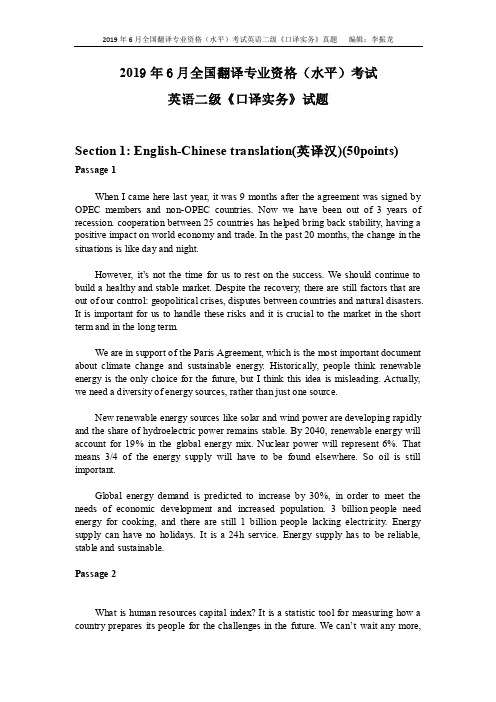
2019年6月全国翻译专业资格(水平)考试英语二级《口译实务》试题Section 1: English-Chinese translation(英译汉)(50points) Passage 1When I came here last year, it was 9 months after the agreement was signed by OPEC members and non-OPEC countries. Now we have been out of 3 years of recession. cooperation between 25 countries has helped bring back stability, having a positive impact on world economy and trade. In the past 20 months, the change in the situations is like day and night.However, it’s not the time for us to rest on the success. We should continue to build a healthy and stable market. Despite the recovery, there are still factors that are out of our control: geopolitical crises, disputes between countries and natural disasters. It is important for us to handle these risks and it is crucial to the market in the short term and in the long term.We are in support of the Paris Agreement, which is the most important document about climate change and sustainable energy. Historically, people think renewable energy is the only choice for the future, but I think this idea is misleading. Actually, we need a diversity of energy sources, rather than just one source.New renewable energy sources like solar and wind power are developing rapidly and the share of hydroelectric power remains stable. By 2040, renewable energy will account for 19% in the global energy mix. Nuclear power will represent 6%. That means 3/4 of the energy supply will have to be found elsewhere. So oil is still important.Global energy demand is predicted to increase by 30%, in order to meet the needs of economic development and increased population. 3 billion people need energy for cooking, and there are still 1 billion people lacking electricity. Energy supply can have no holidays. It is a 24h service. Energy supply has to be reliable, stable and sustainable.Passage 2What is human resources capital index? It is a statistic tool for measuring how a country prepares its people for the challenges in the future. We can’t wait any more,though I know some countries may not feel happy about its ranking.In the past years, many countries have invested much in infrastructure, such as roads, bridges and airports. This is because the social and political benefits of investment in infrastructure are apparent. However, it takes years to see the benefits of investment in human resources, so there is a great gap in countries’ investment in human resources capital, and the gap is likely to widen.The focus of our index is to ask 3 questions: first, how many children in a country can live to 5 years old? second, after reaching the age of 5, how many children go to school? third, when these young people go to the job market, how many have received sufficient training, which lays a good foundation for live-long learning. If children are provided with nutritious food and good health care, they will then request advanced education. However, in many countries, children face chronic lack of nutritious food, health care and school. If their brains don’t develop fully, later when they enter the job market they will be in a disadvantageous situation.If a country doesn’t invest in human resources capital, its economic output cannot increase, and it cannot compete with other countries. Most of my life has been spent on investment in human resources capital in developing countries, and I have seen how the lack of investment in human resources capital has brought miseries. We call on donors to contribute more to these developing countries. However, we should also recognize that the huge needs cannot be met just by foreign aide. It is more important that the developing countries improve their own ability.Investment in human resources capital is important. Developing countries should improve air quality, provide clean water, school bus service, health care and social security.Section 2: Chinese-English translation(汉译英)(50points) Passage 1改革开放40年来,中国的经济发展取得了巨大成就,已经成为世界第二大经济体。
- 1、下载文档前请自行甄别文档内容的完整性,平台不提供额外的编辑、内容补充、找答案等附加服务。
- 2、"仅部分预览"的文档,不可在线预览部分如存在完整性等问题,可反馈申请退款(可完整预览的文档不适用该条件!)。
- 3、如文档侵犯您的权益,请联系客服反馈,我们会尽快为您处理(人工客服工作时间:9:00-18:30)。
2019年6月全国翻译专业资格(水平)考试
英语二级《口译实务》试题
Section 1: English-Chinese translation(英译汉)(50points) Passage 1 When I came here last year, it was 9 months after the agreement was signed by OPEC members and non-OPEC countries. Now we have been out of 3 years of recession. cooperation between 25 countries has helped bring back stability, having a positive impact on world economy and trade. In the past 20 months, the change in the situations is like day and night.
However, it’s not the time for us to rest on the su ccess. We should continue to build a healthy and stable market. Despite the recovery, there are still factors that are out of our control: geopolitical crises, disputes between countries and natural disasters. It is important for us to handle these risks and it is crucial to the market in the short term and in the long term.
We are in support of the Paris Agreement, which is the most important document about climate change and sustainable energy. Historically, people think renewable energy is the only choice for the future, but I think this idea is misleading. Actually, we need a diversity of energy sources, rather than just one source.
New renewable energy sources like solar and wind power are developing rapidly and the share of hydroelectric power remains stable.
By 2040, renewable energy will account for 19% in the global energy mix. Nuclear power will represent 6%. That means 3/4 of the energy supply will have to be found elsewhere. So oil is still important. Global energy demand is predicted to increase by 30%, in order to meet the needs of economic development and increased population. 3 billion people need energy for cooking, and there are still 1 billion people lacking electricity. Energy supply can have no holidays. It is a 24h service. Energy supply has to be reliable, stable and sustainable. Passage 2
What is human resources capital index? It is a statistic tool for measuring how a country prepares its people for the challenges in the future. We can’t wait any more,
though I know some countries may not feel happy about its ranking.
In the past years, many countries have invested much in infrastructure, such as roads, bridges and airports. This is because the social and political benefits of investment in infrastructure are apparent. However, it takes years to see the benefits of investment in human resources, so there is a great gap in countries’ investment in human resources capital, and the gap is likely to widen.
The focus of our index is to ask 3 questions: first, how many children in a country can live to 5 years old? second, after reaching the age of 5, how many children go to school? third, when these young people go to
the job market, how many have received sufficient training, which lays a good foundation for live-long learning. If children are provided with nutritious food and good health care, they will then request advanced education. However, in many countries, children face chronic lack of nutritious food, health care and school. If their brains don’t develop fully, later when they enter the job market they will be in a disadvantageous situation.
If a country doesn’t invest in human resources capital, its economic output cannot increase, and it cannot compete with other countries. Most of my life has been spent on investment in human resources capital in developing countries, and I have seen how the lack of investment in human resources capital has brought miseries. We call on donors to contribute more to these developing countries. However, we should also recognize that the huge needs cannot be met just by foreign aide. It is more important that the developing countries improve their own ability.
Investment in human resources capital is important. Developing countries should improve air quality, provide clean water, school bus service, health care and social security.
Section 2: Chinese-English translation(汉译英)(50points) Passage 1
改革开放40年来,中国的经济发展取得了巨大成就,已经成为世界第二大经济体。
西方一些人由此认为,中国已经成为发达国家,尤
其是在贸易领域,已经具备发达国家的实力。
相应的,中国现在应当承担发达国家的义务。
在此,我想明确的告诉大家,中国仍然是一个发展中国家。
其原因在于:首先,衡量一个国家是否是发达国家最重要的指标是人均GDP。
根据世界银行最新公布的数据,中国的人均GDP是8900美元,接近世界平均水平,但和发达国家仍有很大差距。
其次,中国仍有大量贫困人口。
在中国的农村地区,仍有超过4千万贫困人口,超过很多中等发达国家的人口规模。
这些贫困人口的日收入低于国际上制订。
